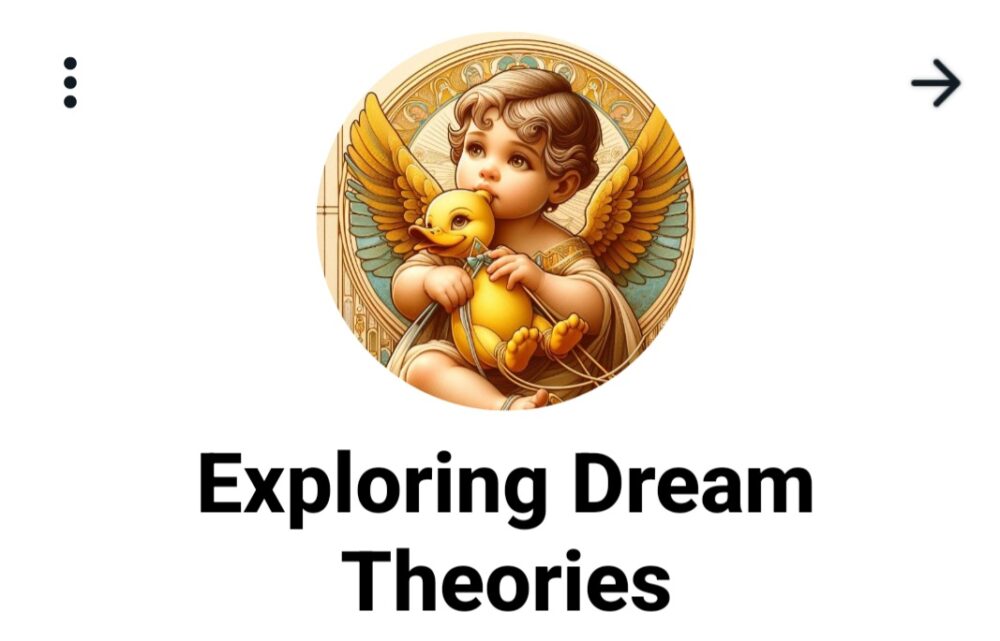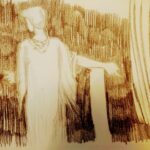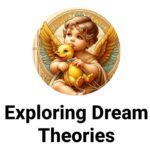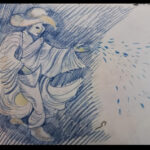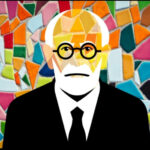Dream theories 🦋💠
Philosophically, lucid dreaming has intrigued thinkers for centuries, from Aristotle, who recognized a form of self-awareness in dreams, to modern philosophers who see it as crucial for understanding consciousness and the mind-body problem. Philosophers like Dennett have debated its nature, suggesting lucid dreams may be “illusions of a dream within a dream,” while others, like Nietzsche and Reid, acknowledged their personal experiences of lucidity during dreams.
Historically, the practice has roots in ancient cultures, such as in the Indian Hindu tradition of Yoga Nidra and the Tibetan Buddhist practice of Dream Yoga, indicating its long-standing recognition and cultivation for spiritual and introspective purposes. Frederik van Eeden coined the term “lucid dream” in the early 20th century, marking a pivotal moment in its study and popularization.
Lucid dreaming, where individuals are aware they are dreaming and can sometimes control the dream’s narrative, is a multifaceted phenomenon encompassing philosophical, historical, and scientific dimensions.
Scientifically, modern research has acknowledged lucid dreaming as a legitimate subject of study, with empirical investigations into its characteristics, induction techniques, and potential therapeutic applications. For example, studies have shown that around 55% of adults have experienced at least one lucid dream, and techniques like reality testing and the Mnemonic Induction of Lucid Dreams (MILD) are among the most researched methods for inducing lucidity. Lucid dreaming presents opportunities for treating nightmares, improving physical skills through dream rehearsal, and enhancing creative problem-solving.
Lucid dreaming is physiologically distinct from non-lucid dreaming and schizophrenic psychosis, with increased frontal lobe activation and synchronicity between the frontal and occipito-parietal parts of the brain, indicating its unique cognitive and neurological footprint. This physiological distinction underscores its potential for therapeutic interventions and further exploration into the mechanisms of consciousness.
In summary, lucid dreaming serves as a fascinating intersection between our understanding of consciousness, the potential for cognitive and therapeutic exploration, and the philosophical implications for our perception of reality and self-awareness.
Incorporating psychoanalytic perspectives into our understanding of lucid dreaming enriches the interpretation of this phenomenon significantly. Psychoanalysis, with its focus on the unconscious mind, internal object relations, and the dynamics of the psyche, offers a compelling lens through which to explore the intricacies of lucid dreaming.
Lucid dreaming, characterized by an individual’s awareness that they are dreaming and sometimes the ability to control the dream narrative, provides a unique opportunity for direct interaction with the unconscious mind. Freud’s theory, which regards dreams as the “royal road to the unconscious,” suggests that lucid dreaming could serve as an amplified pathway to this realm, where repressed desires and unresolved conflicts come to the forefront. The experiences within lucid dreams, such as those detailed by Dr. Raz Even, exemplify how these dreams can enable an introspective examination of deep-seated psychological processes, engaging with unconscious elements in a direct and controlled manner.
Psychoanalytic theory also delves into the significance of internal object relations, particularly the concepts articulated by Klein, Winnicott, Kernberg, and Akhtar, among others. These theories propose that dream characters and scenarios in lucid dreams can be viewed as manifestations of internal objects—representations of significant others internalized during early developmental stages. Such interactions within the dream may reflect ongoing unconscious negotiations with these internalized figures, offering insights into an individual’s object relational dynamics and how past relationships continue to shape their psyche.
Moreover, from a psychoanalytic standpoint, lucid dreaming offers a rich context for the exploration of the psyche’s mechanisms, including repression, projection, and identification. Freud’s notion of dream-work can be applied to understand how latent dream thoughts are transformed into manifest content, with lucid dreaming providing an additional layer of awareness that might alter this process. The dream’s capacity to function as a space for wish fulfillment and the working through of internal conflicts underscores its therapeutic potential, highlighting lucid dreaming as a dynamic space for exploring complex relational dynamics and offering a unique opportunity for psychological growth and self-understanding.
In conclusion, integrating psychoanalytic perspectives into the discussion of lucid dreaming reveals the profound psychological dimensions of dreaming, underscoring lucid dreaming’s potential as a valuable tool for psychological insight, healing, and personal growth. Through this lens, lucid dreaming becomes a profound investigation into the realms of the unconscious, revealing the intricate interplay between conscious awareness and unconscious processes and emphasizing the dream’s role in facilitating a deeper understanding of the self, internal object relations, and the psychological underpinnings of human consciousness.
Winnicott’s work primarily focuses on the concepts of the true self and false self, transitional objects, and the potential space between the individual and their environment, which are central to his psychoanalytic theory. In the context of lucid dreaming, although not explicitly stated in the provided materials, one can infer how his theories might be applied.
Winnicott’s idea of the transitional space, where inner reality and the external world intersect, could be paralleled with the lucid dreaming experience. This space in dreaming allows for a playful exploration and expression of true self without the constraints of external reality. Lucid dreams could serve as a ‘transitional phenomenon,’ offering a safe psychological space to explore personal fears, desires, and fantasies, mirroring Winnicott’s concept of play being crucial for emotional development and the integration of the self.
Furthermore, lucid dreaming could be seen as an arena where the dreamer, aware they are dreaming, navigates between their internal desires (true self) and the dream narrative (potentially influenced by the false self). This awareness and control could symbolize the dreamer’s capacity to engage with their inner reality while simultaneously acknowledging the ‘game’ of the dream, reflecting Winnicott’s emphasis on the importance of play in psychological health and development.
Winnicott’s- his theories offer a rich framework for understanding the psychological significance of these experiences. They highlight the potential of lucid dreams to act as transitional spaces where individuals can explore their true self, engage in symbolic play, and potentially work through psychological issues in a manner that is both creative and therapeutic.
based on the principles of existentialism and the philosophical inquiries related to consciousness, one can infer how existentialists like Jean-Paul Sartre might conceptualize lucid dreaming.
Existentialism, with its emphasis on individual freedom, subjective experience, and personal responsibility, views lucid dreaming as a profound expression of consciousness and a testament to the fluid nature of reality. Lucid dreams, where individuals become aware that they are dreaming and can sometimes control the dream’s narrative, could be seen as epitomizing the existentialist idea that existence precedes essence. In this state, dreamers experience a form of freedom within their own consciousness, navigating a world where they can question the nature of their existence and the constructs of their reality.
Sartre, known for his focus on existential freedom and the inherent nothingness that allows for the emergence of being, might argue that lucid dreaming represents a space where the self can confront its own freedom directly. The lucid dreamer, recognizing their dream state, faces the boundless possibilities of their imagination, illustrating Sartre’s notion of radical freedom and the burden of choice. This awareness within the dream could be likened to the existential awareness of one’s situation in the world, a realization of the freedom to construct meaning amidst an inherently meaningless universe.
Moreover, existentialism’s exploration of authenticity and inauthenticity can be paralleled with the lucid dreaming experience. Lucid dreaming could be seen as a journey towards authenticity, a state where individuals can explore their genuine desires and fears without the constraints of social norms and expectations. The lucid dream offers a unique opportunity to engage with existential questions in a direct, experiential manner, allowing individuals to explore the depths of their being in a setting unbounded by external reality.
In summary, while explicit references to Sartre’s views on lucid dreaming were not found in the documents, an existentialist perspective on lucid dreams would likely emphasize the themes of freedom, authenticity, and the exploration of the self. Lucid dreaming, from this standpoint, serves as a microcosm of existential freedom, a space where the dreamer can experiment with the possibilities of existence and confront the existential dilemmas of consciousness and reality.
R.D. Laing, a Scottish psychiatrist known for his alternative approach to understanding the experiences of psychosis, emphasized the inner reality and personal experiences of individuals. Laing’s work on understanding the self and the other, as well as his exploration of existential questions surrounding identity and reality, suggests that he might view lucid dreaming as a profound opportunity to explore the self. In lucid dreams, where the dreamer becomes aware they are dreaming and can sometimes control the dream’s content, Laing might see a parallel to his concept of “ontological security,” a sense of stability in one’s sense of being in the world. Lucid dreaming could be considered a state where individuals can directly engage with their inner fears, desires, and existential dilemmas, thus offering a unique perspective on their own existence and agency.
Existentialists, broadly speaking, focus on individual freedom, choice, and the inherent search for meaning within the human condition. From an existentialist viewpoint, lucid dreaming could be interpreted as a metaphorical space for existential exploration and self-realization. The lucid dream state offers a scenario where existential freedom and choice become literal, as the dreamer navigates a world bound only by the limits of imagination. This could be seen as a playground for existential experimentation, where the dreamer can confront existential givens—such as isolation, freedom, or death—in a direct but non-threatening manner. Lucid dreaming might also be appreciated for its capacity to illuminate the constructed nature of reality, echoing existential themes of absurdity and the subjective nature of experience.
While Laing might focus on the therapeutic potential of lucid dreaming to reconcile internal conflicts and enhance self-understanding, existentialists might emphasize the dream’s capacity to confront and accept existential truths. Both perspectives, however, highlight the profound psychological and philosophical implications of lucid dreaming as a space for exploring the depths of human consciousness and the boundaries of perceived reality.
Jennifer M. Windt’s work on lucid dreaming, is discussed in the context of a broader examination of the nature and implications of lucid dreaming within the study of consciousness. The discussion acknowledges the contributions of Ursula Voss and Allan Hobson, presenting their exploration of lucid dreaming as a phenomenon that bridges the gap between dreaming and waking consciousness. Voss and Hobson offer a comprehensive overview of lucid dreaming, including its distinctive features and potential for insight into the nature of consciousness itself. The commentary by Lana Kühle on Voss and Hobson’s work highlights the conceptual intricacies and empirical findings regarding lucid dreaming. Kühle delves into the notion of insight within lucid dreams, emphasizing the importance of understanding this phenomenon to gain deeper insights into consciousness. The commentary suggests that lucid dreaming could provide a unique window into the structure of consciousness, including the experience of meta-awareness, self-reflection, and the subjective nature of reality in dreams. Kühle suggests that Voss and Hobson’s hypotheses about lucid dreaming, including the Brain Maturation Hypothesis (BMH), Gamma Band Hypothesis (GBH), Hybrid State Hypothesis (HSH), and Space of Consciousness Hypothesis (SCH), offer a multi-dimensional framework for understanding lucid dreaming. This framework integrates neurological, cognitive, and phenomenological perspectives, aiming to elucidate the mechanisms underlying lucid dreaming and its significance for the study of consciousness. Furthermore, Kühle emphasizes the potential parallels between lucid dreaming and meditative states, suggesting that both phenomena involve forms of meta-awareness or insight that could inform our understanding of consciousness. By exploring these connections, researchers might uncover valuable insights into the nature of self-awareness, self-knowledge, and the capacity for reflection within different states of consciousness. In summary, Jennifer M. Windt’s reference within this discussion underscores the interdisciplinary nature of lucid dreaming research, highlighting its relevance to philosophical, psychological, and neuroscientific inquiries into consciousness. The work of Voss, Hobson, and commentators like Kühle contributes to a richer understanding of lucid dreaming, offering promising avenues for future research on the complexities of human consciousness.
it eloquently outlines the significance of Jennifer M. Windt’s work alongside the contributions of Ursula Voss and Allan Hobson, framing lucid dreaming as a critical intersection between dreaming and waking consciousness. This summary emphasizes the importance of understanding lucid dreaming within the broader context of consciousness studies, highlighting the contributions of these researchers to our comprehension of the nature of consciousness.
Jennifer M. Windt’s research is pivotal in exploring the phenomenological aspects of dreaming and its implications for theories of consciousness and self. By integrating insights from Ursula Voss and Allan Hobson, the summary underscores the multidisciplinary approach required to dissect the intricacies of lucid dreaming. Voss and Hobson’s work, particularly on the neurological underpinnings and cognitive dimensions of lucid dreams, provides a robust foundation for investigating how these experiences bridge waking and dreaming states.
Lana Kühle’s commentary, as noted in the summary, enriches this discourse by highlighting the conceptual and empirical advancements in understanding lucid dreaming. Kühle’s discussion on insight within lucid dreams and the parallels with meditative states further deepens the investigation into consciousness, suggesting a broader spectrum of meta-awareness across different states of being.
The hypotheses mentioned, such as the Brain Maturation Hypothesis, Gamma Band Hypothesis, Hybrid State Hypothesis, and Space of Consciousness Hypothesis, offer a comprehensive framework that spans neurological, cognitive, and phenomenological perspectives. This multidimensional approach is crucial for delving into the complex mechanisms of lucid dreaming and its implications for consciousness research.
In essence, the referenced discussion encapsulates the interdisciplinary nature of lucid dreaming research, illustrating its pivotal role in advancing our understanding of consciousness. The contributions of Jennifer M. Windt, Ursula Voss, Allan Hobson, and Lana Kühle are instrumental in exploring the depths of human consciousness, emphasizing the value of lucid dreaming as a window into the self-aware, reflective nature of the human mind.
- Aristotle. On Dreams. In this ancient text, Aristotle explores early notions of dreaming and touches upon the awareness one might have within a dream state, laying foundational ideas for later philosophical discussions on consciousness and self-awareness in dreams.
- LaBerge, Stephen. Exploring the World of Lucid Dreaming. LaBerge’s seminal work on lucid dreaming provides an extensive overview of the phenomenon, including techniques for inducing lucid dreams and the potential applications for personal and psychological growth. His empirical research has significantly advanced the scientific study of lucid dreaming.
- Voss, Ursula, et al. “Lucid Dreaming: A State of Consciousness with Features of Both Waking and Non-Lucid Dreaming.” Sleep, vol. 32, no. 9, 2009. This study offers critical insights into the neurological underpinnings of lucid dreaming, demonstrating its unique cognitive and physiological characteristics.
- Freud, Sigmund. The Interpretation of Dreams. Freud’s groundbreaking work introduces the concept of dreams as the “royal road to the unconscious,” providing a psychoanalytic framework for understanding dreams, including aspects that can relate to lucid dreaming.
- Tholey, Paul. “Consciousness and Abilities of Dream Figures Observed During Lucid Dreaming.” Perceptual and Motor Skills, 1989. Tholey’s research into the interactions with dream characters in lucid dreams contributes to the psychoanalytic and cognitive exploration of dream content and self-perception.
- Windt, Jennifer M. Dreaming: A Conceptual Framework for Philosophy of Mind and Empirical Research. Windt’s work bridges philosophical and empirical approaches to dreaming, with implications for understanding lucid dreaming within broader discussions of consciousness and self-awareness.
- van Eeden, Frederik. “A Study of Dreams.” Proceedings of the Society for Psychical Research, 1913. In this paper, van Eeden coins the term “lucid dream” and provides early categorizations of different types of dreams, marking a pivotal moment in the study of lucid dreaming.
- Hobson, J. Allan, et al. “The Dreaming Brain: How the Brain Creates Both the Sense and the Nonsense of Dreams.” New York: Basic Books, 1988. Hobson’s work on the neuropsychology of dreaming provides insights into the brain mechanisms underlying dreaming, including lucid dreams.
- Jung, Carl G. Dreams. Jung’s exploration of dreams offers a complementary perspective to Freud’s, emphasizing the symbolic and archetypal nature of dreams. His ideas enrich the psychoanalytic discourse on lucid dreaming, highlighting its potential for accessing deep psychological insights.
- Dennett, Daniel C. “Are Dreams Experiences?” Philosophical Review, vol. 73, 1976. Dennett’s philosophical inquiry into the nature of dreaming challenges traditional notions of dream experiences, contributing to debates on consciousness and the phenomenology of dreaming, including lucid dreaming.
